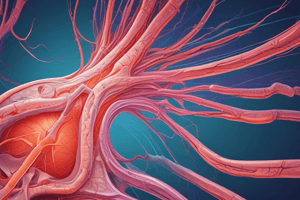Podcast
Questions and Answers
What is the primary function of ground substance in connective tissue?
What is the primary function of ground substance in connective tissue?
- To form a site for storage of fat
- To facilitate the exchange of molecules (correct)
- To provide structural support to the body
- To aid in the defense and protection of the body
What is the main component of the extracellular matrix responsible for its gel-like state?
What is the main component of the extracellular matrix responsible for its gel-like state?
- Elastic fibers
- Reticular fibers
- Aggrecan aggregates (correct)
- Collagen fibers
Which type of glycosaminoglycan is nonsulfated?
Which type of glycosaminoglycan is nonsulfated?
- Chondroitin sulfate
- Keratan sulfate
- Hyaluronic acid (correct)
- Heparan sulfate
What is the origin of most connective tissues?
What is the origin of most connective tissues?
What is the primary component of connective tissue fibers?
What is the primary component of connective tissue fibers?
What is the primary function of fibronectin in connective tissue?
What is the primary function of fibronectin in connective tissue?
What is the main component of connective tissue?
What is the main component of connective tissue?
What is the function of aggrecan aggregates in the extracellular matrix?
What is the function of aggrecan aggregates in the extracellular matrix?
What is the primary function of connective tissue in the body?
What is the primary function of connective tissue in the body?
What is the origin of most connective tissues during embryonic development?
What is the origin of most connective tissues during embryonic development?
What is the function of chondronectin in connective tissue?
What is the function of chondronectin in connective tissue?
What is the function of elastic fibers in connective tissue?
What is the function of elastic fibers in connective tissue?
Flashcards are hidden until you start studying
Study Notes
Characteristics of Connective Tissue
- Forms a continuum with epithelial, muscle, and nervous tissue to maintain a functionally integrated body
- Most connective tissues originate from mesoderm, the middle germ layer of embryonic tissue
- Composed of cells and extracellular matrix consisting of ground substance and fibers
Functions of Connective Tissue
- Provides structural support
- Serves as a medium for exchange
- Aids in the defense and protection of the body
- Forms a site for storage of fat
Ground Substance
- Hydrated, amorphous material
- Composed of: • Glycosaminoglycans (sulfated and nonsulfated) • Proteoglycans (covalently linked to hyaluronic acid, forming aggrecan aggregates) • Adhesive glycoproteins (various types, including laminin, chondronectin, osteonectin, and fibronectin)
Fibers of Connective Tissue
- Elongated structures formed from proteins that polymerize after secretion from fibroblasts
- Three main types of fibers: • Collagen fibers • Reticular fibers • Elastic fibers
Characteristics of Connective Tissue
- Forms a continuum with epithelial, muscle, and nervous tissue to maintain a functionally integrated body
- Most connective tissues originate from mesoderm, the middle germ layer of embryonic tissue
- Composed of cells and extracellular matrix consisting of ground substance and fibers
Functions of Connective Tissue
- Provides structural support
- Serves as a medium for exchange
- Aids in the defense and protection of the body
- Forms a site for storage of fat
Ground Substance
- Hydrated, amorphous material
- Composed of: • Glycosaminoglycans (sulfated and nonsulfated) • Proteoglycans (covalently linked to hyaluronic acid, forming aggrecan aggregates) • Adhesive glycoproteins (various types, including laminin, chondronectin, osteonectin, and fibronectin)
Fibers of Connective Tissue
- Elongated structures formed from proteins that polymerize after secretion from fibroblasts
- Three main types of fibers: • Collagen fibers • Reticular fibers • Elastic fibers
Studying That Suits You
Use AI to generate personalized quizzes and flashcards to suit your learning preferences.




